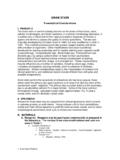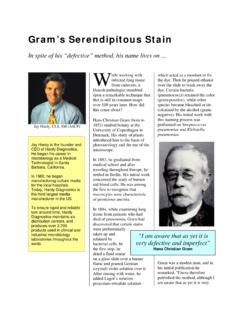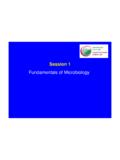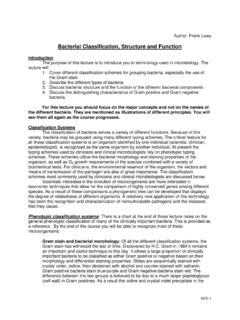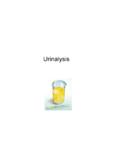Transcription of Exercise 5 Smear and stain F10 - bulletworm.com
1 20 Exercise 5 (Ed. Fall 2010) THE PREPARATION OF A BACTERIAL Smear FOR STAINING: The Simple stain , gram stain , Acid Fast stain , Capsule stain and Endospore stain INTRODUCTION: Student Learning Objectives: At the end of this Exercise , student will be able to: 1. Describe the methods of preparation of a bacterial Smear from broth and solid media. 2. Describe the attributes of an ideal Smear . 3. Identify the factors which can result in a less-than-ideal Smear . 4. Define the purpose of the specific staining methods used to stain bacteria. 5. Prepare the specimen for staining (heat fixing). 6. Successfully perform the Simple stain , gram stain , Acid Fast stain , Capsule stain , and Endospore stain on known cultures. 7. Define Quality Control and perform a QC test with the gram stain 8. gram stain an unknown culture. Materials - Broth cultures of Streptococcus pyogenes, Micrococcus luteus, and Bacillus subtilis (18 24 hours) - Broth culture of S.
2 Aureus and B. subtilis over 48 hours old. - Slant cultures of E. coli, Bacillus subtilis, Neisseria sicca, Klebsiella pneumoniae, and Pseudomonas aeruginosa. - Slant culture of Staphylococcus aureus. - Slant culture of Mycobacterium smegmatis and Corynebacterium sp. - Inoculating loop - Bunsen burner - Distilled water and medicine dropper. - Microscope and slides - gram staining kit, Methylene Blue stain , India ink, Malachite Green, and Safranin (other than gram s Safranin). - Bibulous paper - Wax pencils Activities for PART 1: 1. Prepare bacterial smears on slides and heat fix where applicable. 2. Using methylene blue, prepare a simple stain of bacteria. 3. Using the gram stain method, prepare a differential stain . Activities for PART 2: 1. Using the India ink and Crystal Violet stains, prepare a differentail capsule stain . 2. Using Malachite Green and Safranin, prepare an endospore stain .
3 21 Introduction To visualize bacteria under a light microscope, several staining methods are employed. However, the stain is as good as the starting material on the microscope slide, which is the bacterial Smear . If the Smear is less than ideal (Bad Smear ), then staining the specimen would not be productive and can yield inconclusive results at best. Since bacteria are grown in both liquid and solid media (broth and agar), specimens must be obtained using the appropriate tools and collecting the ideal amount for the Smear . Too much can result in a very thick Smear which can stain irregularly, and too little can result in a Smear where bacteria will be too difficult to find. Another factor that can affect staining is the age of the culture; in the case of gram positive bacteria, older cultures (>24 hours) tend to yield a non-uniform gram stain , where although the culture is a pure culture, it will appear as if it were a mixed culture with both gram positive (bleu) and gram negative (reddish) organisms in the same Smear .
4 To avoid this, only young cultures are used for gram -staining bacteria. As you well know, bacteria can come in different shapes, sizes, and arrangements. Some may have extra cellular structures such as a capsule, while others may form a dormant structure such as an endospore when conditions are less than favorable for survival. In this Exercise , you will use specific stains that will enable you to see these structures. Also, bacteria are known to grow in specific arrangements such as chains, bunches, diplococci, and tetrads. To be able to see the normal arrangement of these bacteria, it is best to obtain the Smear from a broth culture where the bacteria are growing in a suspended medium. Obtaining a Smear from a solid agar will usually result in rearrangement of their normal growth patterns. Remember your aseptic technique for this Exercise , and well as the fact that you will be handling potential pathogens.
5 Staining is a messy procedure, so make sure to avoid spilling the stains on expensive clothing, shoes, and of course your eyes and skin. When you open the stain containers, or replace them back on the desk, please make sure that the spout is closed and is pointing away from you and others to avoid the stains from splashing into eyes. Wear eye protection if deemed necessary. Wear gloves if they do not get in the way of your procedures. Discard all waste stain material in the appropriate containers. Waste water goes in the designated buckets. Stained slides go in the beaker at the front of the room. Do not dump anything in the sink. If you spill it, clean it up before the stain sets. Check with your instructor if you are not sure. 22 Activities for Part 1 1. Preparing a Smear from a Broth Culture - Label two clean slides with your initials and the number 1 and 2.
6 - Using your wax pencil, make a circle about the size of a nickel on the top surface of these slides. Sometimes it is easier to make the circles if you warm the slide by putting it on the staining hot plate. The object of the circle on the slide is twofold. First, the circle serves to contain the specimen, so it doesn t fall off the slide if it is a liquid specimen. Second, the circle will help you focus your specimen area. - Aseptically transfer one loopful of the B. subtilis broth culture and place it inside the circle of slide 1, and another loopful inside the circle of slide 2. Allow them to air-dry. - Asetically transfer a second loopful to slide 2 and place it on top of the first dried loopful. Allow it to air-dry. - Turn on your Bunsen burner and quickly pass the slides through the flame 2 or three times. Heat fix the specimen kills the bacteria and causes them to stick to the glass surface so they don t wash off during the staining procedure.
7 - The slides should be very warm but not too hot to touch with the back of your hand. - Allow the slides to cool off before staining. By using at least two different amount of the broth, you will be able to tell which is the ideal amount for the Smear after staining. Although you cannot count the bacteria in the broth culture, the higher turbidity usually indicates a higher number of bacteria suspended in the medium, compared to a medium with little turbidity. 2. Preparing a Smear from a Solid Medium (agar slants) - Label two clean slides with your initials and the numbers 3 and 4. - Draw a circle with your wax pencil as indicated above. - Place a small drop of water (2 3 loopfuls) in the circle of each slide. - Aseptically transfer a small amount of E. coli from the slant culture using the needle and mix it with the water on slide 3. Allow it to air dry.
8 - Aseptically transfer an even smaller amount by barely touching the surface of the slant and mix it with the water on slide 4. Allow it to air dry. - Heat fix both slides and allow to cool off before staining. By using at least two different amounts of cells from the slant culture, you will be able to tell which amount is ideal for making a good Smear after staining. You can thin out the Smear by adding more water and spreading the bacteria over a larger area, or by using less bacteria in the first place. Now you are ready to stain the slides. Start your procedure by clearing off any unwanted items from your desk area. Place all the needed stains within reach, so you don t have to run off to find the stains. Make sure your stainless steel waste water receptacle and the staining rack are in place. Have enough paper towels at hand in case of spills.
9 Read the staining procedures and understand the steps BEFORE you start staining your slides. 23 3. The Simple stain - Place slide 1 from above Exercise on the staining rack and flood with Methylene Blue. - Allow to stain for 1 minute. - Using the staining tongs/forceps, tilt at an angel to allow stain to drain off slide. - Wash/rinse off excess stain from slide and blot with bibulous paper. To blot, you may place the slide inside the booklet and gently press on it. Allow slide to dry out completely before viewing. Repeat the same procedure with the other three slides. After viewing the slides under high power and oil immersion, determine which of these had the ideal amount of specimen to make a good Smear . This will help you determine the amount of specimen (concentration of cells) you need to make good smears for the rest of the course. Now procede to the next stain , and perhaps the most important stain in your Microbiology course, the gram stain .
10 Draw your findings in the circles below and complete the information in the table. Slide 1 Slide 2 Slide 3 Slide 4 Smear / Slide # Smear (Describe) Evaluation (Too few, Good, Too many) 244. The gram stain This activity to be done in pairs. Everyone should become proficient at this staining method. Prepare the following bacterial smears as you have done in the previous exercises from the following sources: - Broth cultures of Streptococcus pyogenes and Micrococcus luteus (18 24 hours) - Broth culture of S. aureus over 48 hours old. - Slant cultures of E. coli, Bacillus subtilis, Neisseria sicca, Staphylococcus aureus, and Streptococcus pyogenes. Procedure: Heat fix your slides. What does heating the slide do? _____ Staining the Slides. - Place the slide on the staining rack. - Flood the slide with Crystal Violet for 1 minute.

